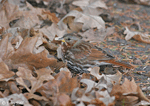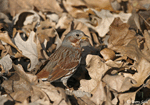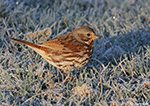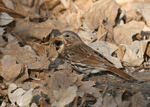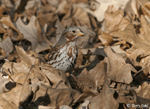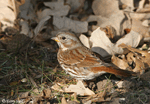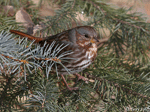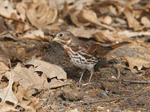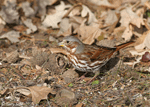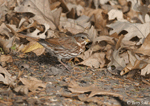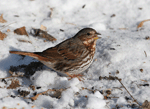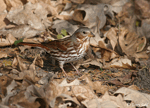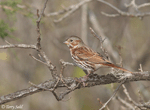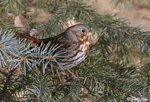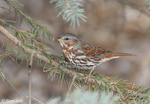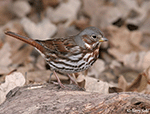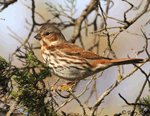| Length: 7 inches | Wingspan: 11 inches | Seasonality: Migrant |
| ID Keys: Large size for a sparrow, ground-scratching behavior, triangular spots on underparts | ||
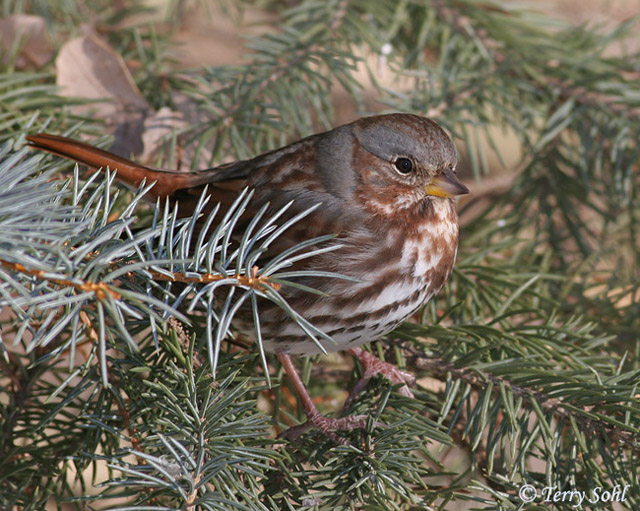 The Fox Sparrow is a large, chunky bird which only visits South Dakota during migration.
Somewhat shy birds, they strongly prefer thick vegetation, and are most often
seen on the ground as they scratch for food items. There are a great many
color variations depending on geographic area. Most birds in the eastern or
northern part of their range have a rich, reddish-brown color (and are sometimes
known as the "Red Fox Sparrow"). Moving further to the west, those of the
intermountain West of North America have a more uniformly gray back and head
that contrasts with a rich rusty tail and rump, and are called the
"Slate-colored Fox Sparrow". Those along the North American coast are a dark
grayish-brown, and are sometimes referred to as the "Sooty-colored Fox Sparrow".
Songs of the various local races are also slightly different.
The Fox Sparrow is a large, chunky bird which only visits South Dakota during migration.
Somewhat shy birds, they strongly prefer thick vegetation, and are most often
seen on the ground as they scratch for food items. There are a great many
color variations depending on geographic area. Most birds in the eastern or
northern part of their range have a rich, reddish-brown color (and are sometimes
known as the "Red Fox Sparrow"). Moving further to the west, those of the
intermountain West of North America have a more uniformly gray back and head
that contrasts with a rich rusty tail and rump, and are called the
"Slate-colored Fox Sparrow". Those along the North American coast are a dark
grayish-brown, and are sometimes referred to as the "Sooty-colored Fox Sparrow".
Songs of the various local races are also slightly different.
Habitat:
Prefers brushy areas, primarily thick forest undergrowth. Can be found in suburban areas, but usually around well-vegetated areas.
Diet:
Primarily feeds on seeds, especially during migration and the winter. In the summer, also feeds heavily on insects and spiders. May also occasionally feed on fruits and berries, and small marine life along the coasts.
Behavior:
Primarily feeds on the ground, often scratching through the leaf litter. They will often hop or make short flights to move to another foraging location, or when fleeing danger, rather than make longer sustained flights. Fox Sparrows tend to be found alone or in small groups, rather than in large flocks of their own species (although they will join mixed foraging flocks of sparrows).
Breeding:
Non-breeder in South Dakota. In breeding range, the Fox Sparrow nest is a cup of grasses, weeds, and other plant material, built in a shrub or small tree, usually within 10 feet of the ground. The female usually lays between 3 and 5 eggs, and she alone incubates them. When the eggs hatch, both parents help to feed the young. The young fledge in about 10 days.
Song:
The song of a Fox Sparrow is a rich series of whistled notes, with some buzzy edges to some of the notes. Note songs vary between different regions and races of Fox Sparrows. Eastern birds tend to have a richer, more melodic song, while those in the west often have more buzzy and harsh elements amongst the whistled notes. Fox Sparrows also have a hard chek call note.
- Click here to hear the song of a Fox Sparrow1
- Click here to hear the hard chek call notes of a Fox Sparrow2
- Click here to hear another song version of a Fox Sparrow3
Migration:
Summers throughout Canada, Alaska, and higher elevations of the western United States. Winters throughout the southeastern United States, along the U.S. West Coast, the Southwest U.S., and Mexico.
Interactive eBird Map:
Click here to access an interactive eBird map of Fox Sparrow sightings
Similar Species:
The very heavy streaking, as well as their habit of scratching through the leaf litter, distinguish them from some other streaked sparrow species. Here are the species most likely to be confused with a Fox Sparrow:
- Song Sparrow - Both Song Sparrows and Fox Sparrows show some variation in plumage across their range, particularly in terms of how "red" or how brown a given local race may be. There are some common characteristics though that can be used to differentiate them, across the various local races. Song Sparrows have a grayish bill, compared to the yellow and dark bill of a Fox Sparrow. Song Sparrows have a dark spot in the middle of the chest (although the pattern of spots on a Fox Sparrow may give the appearance of a central breast spot). Finally, Song Sparrows have an obvious eye stripe, extending from the eye itself and backwards towards the nape.
- Savannah Sparrow - Savannah Sparrows are heavily streaked like a Fox Sparrow, but the streaks are finer and more defined than the broad streaks of a Fox Sparrow. They have a pinkish bill (yellow/dark on a Fox Sparrow), and have a noticeable eye-stripe behind the eye. Savannah Sparrows also tend to have a yellow spot on the lore in front of the eye.
- Vesper Sparrow - One more heavily streaked sparrow, the streaking on a Vesper Sparrow is narrower and more defined than that of a Fox Sparrow. Vesper Sparrows have an obvious light eye-ring that's lacking on a Fox Sparrow, and also have obvious white outer tail feathers.
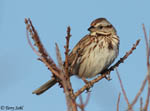 |
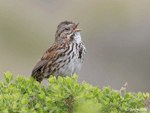 |
 |
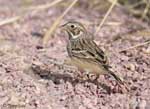 |
| Song Sparrow | Song Sparrow | Savannah Sparrow | Vesper Sparrow |
Bird Feeders:
Will attend feeders for scattered birdseed and bread crumbs. Fox Sparrows feed on the ground, and will generally hang out below any feeders, scratching on the ground for seeds that may have fallen. They may also sit on platform feeders.
Conservation Status:
Systematic surveys in recent decades show generally stable populations. They are found across a very broad geographic area, and are common in parts of that range. Overall, there are no serious concerns for Fox Sparrow populations, and the IUCN lists the Fox Sparrow as a species of "Least concern".
Further Information:
- USGS Patuxent Bird Identification InfoCenter, Fox Sparrow
- WhatBird - Fox Sparrow
- Audubon Guide - Fox Sparrow
Photo Information:
November 4th, 2007 - Big Sioux Recreation Area near Brandon - Terry Sohl
Additional Photos:
Click on the image chips or text links below for additional, higher-resolution Fox Sparrow photos.
Audio File Credits:
- 1Steve Hampton. Recorded in the Nome Census area of Alaska on June 3rd, 2017. Original recording and information available from xeno-canto.
- 2Jeff Dyck. Recorded in British Columbia on July 8th, 2018. Original recording and information available from xeno-canto.
- 3Patrik Aberg. Recorded near Nome, Alaska on June 6th, 2017. Original recording and information available from xeno-canto.
| Click on the map below for a higher-resolution view |
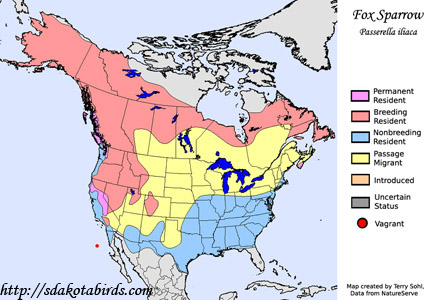 |
| South Dakota Status: Uncommon migrant in the eastern half of the state, rare in the west. Casual in winter. |
Additional Fox Sparrow Photos
Click for a higher-resolution version of these photos
